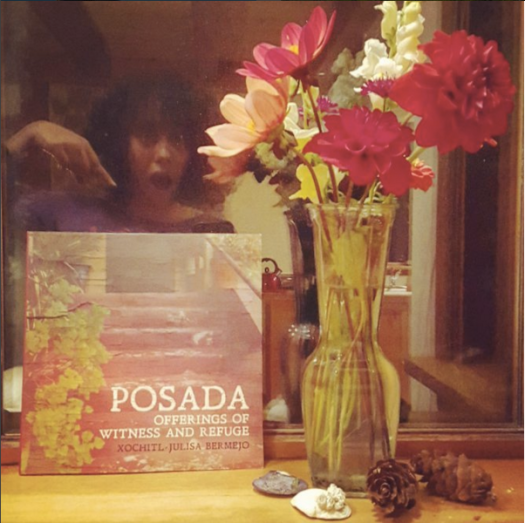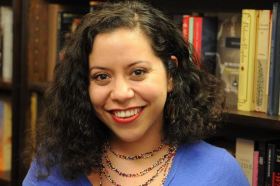by Xochitl-Julisa Bermejo
This article was first published in July 2017. The current deadline for Hedgebrook 2019 residencies is Tuesday, July 24th.
Hedgebrook’s 2018 Writer in Residence is now open. The deadline for applying is July 25th. Though there is a $30 application fee, rumor is you can request a fee waiver based on need, and if you are accepted, the stay–which includes room and board–is free of any cost aside from travel costs to Whidbey Island an hour outside of Seattle, Washington.
Hedgebrook is an all-female and female-identifying writing retreat. Writers stay in their own little cabin in the woods equipped with a desk and fisherman’s fireplace, and are given three meals-a-day, which includes a community dinner each night. No more than seven writers are on the premises at one time. One aspect that makes this residency highly sought out is Hedgbrook’s belief in radical hospitality. Some highlights of this include: menus catered to each writer’s specific food needs (and even the occasional favorite comfort food), fresh baked cookies daily, a well-loved garden writers are encouraged to pick flowers from for their desks, and absolutely no pressure to write. As someone who has experienced Hedgebrook, you and your writing will rarely feel so nurtured.

From “A Cottage of One’s Own” by Rebecca Sutton:
The stoves are one of many details at Hedgebrook designed to stoke the fire within writers, who spend two to six weeks here in groups of six women. There are private, hand-built cabins, home-cooked meals, 48 acres of forested beauty, and stunning views of Mount Rainier and Puget Sound. Together, this has rendered Hedgebrook—a frequent NEA grantee—a special place to write and grow. “There are so few places in the world and in our lives where women feel safe; where they feel like they have sanctuary; where they feel like all of the other things that are asked of them and demanded of them are taken care of so that they can just be a writer and do their work,” said playwright and Hedgebrook Executive Director Amy Wheeler.
But Hedgebrook is not easy to get into. With the numbers of applications rising each year, the amount of residencies awarded is fixed at 40. That’s at about a 2% acceptance rate. Do not let this stop you!
For help, check out these tips from “Building Up to Emerging,” an essay I published on our blog last year about applying to workshops, residencies, and fellowships:
a. Send your BEST work. I have heard this from a few writers. Do not send a sample of new writing that you wish to work on while in residency, but send writing that’s been perfected and even published. If what you submit is not what you want to work on, and you get accepted, that’s ok. No one will be checking.
b. If an application asks why you want to attend, come up with a more specific answer than needing a place to write. This advice came from a Hedgebrook alumna. Again, think of the application like a college essay. Hedgebrook receives close to 1000 applications. The first round is read by alumna, which select about 10% to go into round two, so you want to say something that makes you stand out.
c. When writing a project proposal, name your research sources. I got this advice from my eldest brother who is currently working on a PhD in Communications from University of Maryland. Back in 2007, when I was working on my Antioch University MFA application, I asked him to read my essay of intent. In it I mentioned my interest in social justice writing and poetry of witness but didn’t give specifics. His advice was to go back and name the research I had done, the books I had been reading, the writers I was studying as proof. Basically, let your application show the work you’ve already done and name names.
If you’re still like, “What’s the Deal with Writing Residencies?” check out the essay of the same name by Elisa Gabbert:
What value do residencies offer for writers? Is it mainly a way to get time and space to write? Or are they also important for resume-building, industry networking, getting an agent, getting a job?
The value of residencies is the work you do while you’re there, with social networking as an option. What you do is really and truly up to you. One of my favorite things I ever heard was said on my first day at Millay: “You’re here to honor yourself as a writer,” the residency director said while giving the tour. “If that means reading, rather than writing, that’s fine by us.” I found that really liberating — and of course, once I felt free to do what I craved, which was curl up on the studio couch with a handful of poetry collections, I was inspired to write.
Different residency spaces, and how long you have in them, shape the work that will get done. A brief stay might be best for editing an existing story or essay. A studio with pegboard walls and lots of floor space is perfect for laying out pages that need to be ordered for a poetry manuscript. A desk next to a big window might inspire new drafts, while an Adirondack chair beside a river might become a favorite reading spot. I make a conscious effort to take cues from the setting.
Personally, my ideal setting is “pretty but not too exotic.” I’m always subconsciously looking for excuses to not write, and I don’t want the landscape to be one of them. Many of the spaces that become residencies have fascinating back-stories. On the grounds of Millay you can still see the ghost-outline of poet Edna St. Vincent Millay’s tennis court, and track down her repository field of empty gin bottles. The Hermitage was a nudist colony at one point.
As an added line to a resume or curriculum vitae, attending a residency won’t make a big difference. But most gatekeepers, by whom I might mean a prospective agent or someone interviewing you for a teaching job or fellowship, are members of the literary world themselves. If you can deepen your connection with them based on shared familiarity with a residency — Yaddo and MacDowell are known to have the power to do this — that can help.
And hey! Don’t forget that Hedgebrook isn’t the only writing residency out there. Check out “27 Amazing Writing Residencies You Should Apply for This Year,” for a starting list. Also Gettysburg National Park, 360 Xochi Quetzal, and Yaddo all have upcoming deadlines.
 Xochitl-Julisa Bermejo is the author of Posada: Offerings of Witness and Refuge (Sundress Publications 2016), a 2016-2017 Steinbeck fellow and former Poets & Writers California Writers Exchange winner. She has work published in Acentos Review, CALYX, crazyhorse, and The James Franco Review and is a cofounder of Women Who Submit.
Xochitl-Julisa Bermejo is the author of Posada: Offerings of Witness and Refuge (Sundress Publications 2016), a 2016-2017 Steinbeck fellow and former Poets & Writers California Writers Exchange winner. She has work published in Acentos Review, CALYX, crazyhorse, and The James Franco Review and is a cofounder of Women Who Submit.

